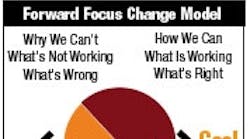By Ed Oakley
Recently I had the pleasure of presenting the opening keynote address for the Supply Chain Council annual conference in Philadelphia. In this talk, I did an informal survey. The extreme response surprised me. Literally 100% of the nearly 300 people who raised their hand indicated that they did not have direct authority over the people who were needed to accomplish their supply chain improvement goals.
While that might be an extreme situation, it is quite common for managers responsible for major change initiatives to feel limited in their authority, even if they have a formal charter.
What Are the Key Challenges of Change Initiatives?
In a more formal survey that my firm did recently, over one hundred people shared their challenges of managing complex change initiatives. Following are some of the most consistent responses we received:
- Misalignment among the stakeholders about the real mission.
- Cross-boundary conflicts.
- Challenges in communicating and influencing upward.
- Resistance to change from key people. Hidden agendas sabotaging efforts.
- Mixed messages around requirements and assumptions.
- Making the shift from managing to leading.
Three of these challenges were major hurdles in three client initiatives, the successful completion of which generated the following results: A pharmaceutical company saved over $250,000 in one supply chain meeting; a computer company saved $9 million in inventory in 6 months; and a paper manufacturer saved 1,800 jobs by turning around a failing manufacturing facility.
The three consistent challenges of these change initiatives were: 1) overcoming resistance to change, 2) making the shift from managing to leading, and 3) getting stakeholders aligned with the mission. In this article, the first of three, I will focus on practical strategies for dealing with such challenges. This article will focus on a simple strategy for overcoming resistance to change.
Shifting Resistance to Change into Wholehearted Commitment
A friend of mine was a store manager of a fast-growing coffee company. Zack absolutely loved his job and the company. His employees loved him, as did the store's customers. He represented the epitome of the company's people-oriented culture. His store performance reflected his attitude, as it was consistently in the top 10-20% of the stores in his high-performing district.
Then one day a re-organization occurred and Zack got a new district manager. The manager immediately began nitpicking Zack's performance, focusing all of his attention on "problems."
While his intention was to encourage even higher performance, his approach was dishonoring and debilitating. Within six weeks Zack felt so beat up that he left the company and a job he loved very much. When he left that company lost a tiny bit of the special culture it had worked so hard to attain. This might be an extreme example. Many people would not be as sensitive as my friend, but you can bet the problemoriented style of the new manager affects many others in a similar way.
"Don't ask people to do something differently until you first acknowledge what they are already doing well," I often say. If people don't feel valued, they will become defensive when asked—no matter how nicely—to change what they are doing. It is a natural defense mechanism.
As a project or program manager, change agent, internal consultant or whatever your role, you have a choice about where you focus your attention and energy. The following graphic, first introduced in our book, Enlightened Leadership: Getting to the Heart of Change (Oakley & Krug, Renewal/Fireside, 1991), depicts some of those choices:
What managers might not realize is how they might be contributing to a "resistance to change." To the extent you focus your attention on what's wrong or what's not working, you create an environment of defensiveness, which looks like resistance to change.
I am not suggesting that managers should ignore problems, but what happens when you throw the problem onto the conference room table and proceed to analyze it? Instantly, everyone in the room moves into a defensive posture, wanting to make sure they don't personally get blamed for the problem. All of that energy spent on self-protection and defensiveness is not available for the creativity we need to find solutions. Any backward focused energy is going to look like resistance to change. No one wants to be part of the problem, but everyone wants to be part of the successes and the solution!
A Different Approach
If, instead, you were to begin by acknowledging the successes, the things that are working, the progress toward the goal so far, the team members would feel valued and more open to look at what's needed next to move closer to the goal—the solutions. People want to feel valued for what they are already doing, and to the extent they do, they are more open to looking at doing things differently. This is what I call "forward focus."
People don't resist change so much as they resist being changed. When people feel valued and acknowledged, then participate in determining solutions, they are likely to buy-in and commit easily and quickly. One could argue that the traditional "find the problem and fix it" approach also provides the involvement. While that is true, a key distinction here is focusing significant energy and attention on what is already working as a prelude to diving into problem solving.
Additionally, this approach focuses on finding a solution quickly, and not getting bogged down initially in finding the cause of the problem. You can always go back and do root cause analysis later if it is needed to improve the system, however, when we stay forward focused, the system enhancement or repair often falls out naturally as part of the solution.
A Real-World Example
There was tremendous resistance and defensiveness in the room when the supply chain vice president of the pharmaceutical company began his meeting in Europe. Everyone knew that there was a serious lead-time issue with a major product, and it had been unresolved for at least six months, even though several attempts had been made to solve the problem with traditional approaches.
The vice president had experienced an Enlightened Leadership Solutions executive development session and was going to try something different. He had alerted the group in advance to be prepared to start the meeting by sharing successes they were having with respect to their supply chain roles. While they were a bit suspicious of this approach, they came prepared. The more they shared, the more realizations they had about their successes. They became more and more energized and enthusiastic as they shared what was working to kick off the meeting. From this highly energized and honoring place the group quickly found an innovative solution to the problem, one that was simple, elegant and easy to implement. That one change cut 20 days from the product lead-time and saved over $250,000.
In summary, by shifting the balance of where you focus your attention and energy to staying forward focused as much as possible greatly reduces resistance to change. It honors people for where they are and naturally encourages them to contribute to the change process.
Ed Oakley is founder and CEO of Enlightened Leadership Solutions (Denver, www.enleadership.com). His most recent book is Leadership Made Simple: Practical Solutions to Your Greatest Management Challenges. Contact him at [email protected] or 303729-0540.
| Change management, part 1 of 3: This article is the first in a three-part series by Ed Oakley on how to manage change successfully. Future articles will focus on making the shift from managing to leading and aligning disparate groups or stakeholders. |



